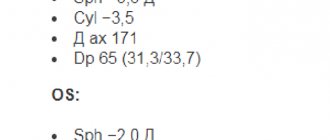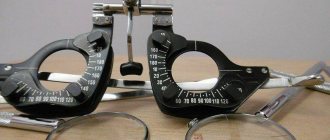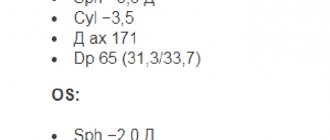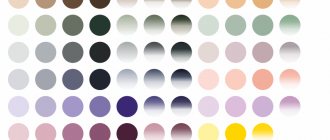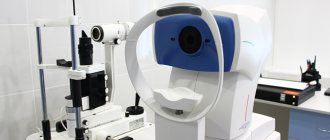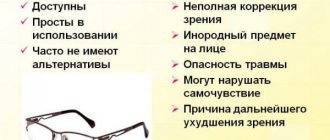When visiting an ophthalmologist with complaints of poor vision, patients are given a prescription for glasses, deciphering which is a rather difficult task. After conducting a number of diagnostic examinations, the doctor, having studied all the patient’s complaints, will conduct an examination of the visual organs using a slit lamp. Based on the results of the tests, a prescription for glasses or contact lenses will be issued. More details about deciphering a prescription for glasses will be discussed in this article.
Glasses prescription - explanation
Decoding a prescription for glasses
The prescription form that the doctor writes out contains an abbreviation in a foreign language. This is Latin. Before you begin decoding, you first need to understand how the right eye is marked in the recipe, and how the data for the left is recorded. This sequence was not chosen by chance, so that in the end no mistakes were made when selecting points.
Visual acuity test
Table. Abbreviations in eyeglass prescriptions.
| Symbols | Meaning |
| O.D. | This is how the right eye is designated in the recipe (the abbreviation is oculus dexter). Typically, these symbols can be seen on the left side of the prescription form. On the opposite side the characteristic required for the adjustment is indicated. |
| OS | The left eye is marked with these symbols in the recipe (the abbreviation is oculus sinister). On the form, information about the patient's left eye can be seen slightly below the information about the right eye. |
| OU | Oculus uterque (abbreviated OU) are the symbols that characterize both eyes. As a rule, doctors write this when the same adjustments are required in both eyes at once. Using an abbreviation saves time and is also convenient. |
| Sph | Doctors use these symbols to denote such a thing as optical power (the full word is sphere). This indicator is measured in diopters. When treating an ophthalmological disease such as myopia or farsightedness, this characteristic is considered the most important. |
| Cyl | An abbreviation of the word cylinder. It is with these symbols that doctors mark optical gain in a glasses prescription. Typically, a cylindrical lens, the optical enhancement of which was mentioned above, is often used in the treatment of astigmatism. |
| Prism | When compiling a prescription form for glasses, this word refers to lenses that have a prismatic shape. In ophthalmology they are used in the treatment of diseases such as myopia. |
| Ax | This is an abbreviation for the word axis, which stands for axis of cylindrical inclination. Readings are measured in degrees and range from 0 to 180 degrees. |
| Add | Another indicator that can be seen in a doctor’s prescription. This is the difference between far and near vision, measured in diopters. Used in ophthalmological practice to create bifocal glasses for the treatment of presbyopia. |
| Dp | Unlike previous indications, which acted as an abbreviation for one word, Dp is an abbreviation for an entire phrase in Latin. This is distancia pupilorum. The Dp value itself represents the distance between the patient’s pupils, or more precisely, between their centers. |
Eyesight check
On a note! Most of the information you need to decipher recipes can be easily found on the Internet. But before you start reading and decoding the data yourself, you need to consult an ophthalmologist. Ask him about the most important indicators in the recipe.
Recipe example
As an example, let’s look at a prescription for glasses with this content.
Example of a prescription for glasses
Now, having information about the meaning of all the characters, you need to try to decrypt the data. First of all, you need to correct the existing myopia. This requires a special 2 diopter lens. As a treatment lens for astigmatism, toric lenses are required, which have a refractive power of 2.5 diopters. This all applies to the left eye, now let’s look at the information on the right.
Glasses prescription
The left eye needs a stronger lens (3.8 diopters) to correct myopia. To correct astigmatism in the left eye, it is necessary to use a special toric lens with a power of 3.5 diopters. If we talk about the exact distance between the pupils, then in this case it is 65 mm.
What glasses can be prescribed?
Depending on the diagnosis, the patient may be prescribed different types of glasses, for example, for distance, progressive, office glasses for working on a computer, etc. Let's consider each of these types separately.
Optometry
For distance
They need to be worn on a regular basis, since such glasses are prescribed to those people who have difficulty seeing various objects in the distance. They are also used when driving a vehicle, when going to a theater or cinema, where you need to clearly view objects at a great distance. As a rule, such glasses are prescribed with special single-vision lenses.
Glasses for myopia
For up close
Unlike the previous option, such glasses are needed only for reading books or for working at a computer, when there is a need to look at objects up close. As with distance glasses, single vision lenses are used here.
Glasses for farsightedness
Progressive
In this case, the glasses are equipped with multifocal lenses that combine the qualities of glasses for long and short distances. Doctors prescribe such glasses in cases where the patient needs to clearly see objects at different distances.
Progressive lenses
Progressive Lens Zones
Office
A fairly common version of glasses used by office workers. As a rule, such glasses are worn by people over 40 years old. The peculiarity of office lenses is that there is no need to remove them when trying to see something at medium distances. For example, you work hard all day in front of a computer monitor, but if someone walks into your room or office, you don’t need to take off your glasses to see the person.
Office glasses
What should a glasses prescription include?
In what cases is it recommended to consult an ophthalmologist?
Even if you have excellent vision and no complaints, it is recommended to undergo an examination by an ophthalmologist once a year. But many people neglect this advice until serious problems occur. It is recommended to make an appointment with an ophthalmologist in the following situations:
- You constantly squint in order to see the inscription on a billboard or sign;
- Vision deteriorates in low light and at dusk;
- You have a hard time reading - letters blur, move or merge;
- When you strain your eyes for a long time, for example, when working at a computer, your head starts to hurt.
The symptoms described above indicate a deterioration in vision, which can only be corrected with glasses.
Factors to consider
Despite the exact parameters specified in the recipe, some inspectors who work in workshops may make minor changes. For example, they adjust the power of an astigmatic lens or change the axis angle (usually the angle changes by 90 degrees). As a result, the patient receives completely different glasses. But such changes should not scare you, since the data on the prescribed prescription and the points received have the same parameters.
Making glasses
To ensure effective treatment of astigmatism with glasses or contact lenses, the prescription must be written exclusively by a professional ophthalmologist. This should only happen after a diagnostic examination has been carried out. For those patients who have not previously had to wear glasses, the increase in the optical power of the lenses should occur gradually. Initially, the doctor prescribes weaker lenses to speed up the adaptation process. After a few months, repeated diagnostics are needed to prescribe other, stronger lenses. Sometimes such procedures need to be repeated 2-3 times or more.
On a note! Regardless of whether you have vision or eye problems, diagnostic examinations by an ophthalmologist should be performed regularly. This will allow timely identification of possible abnormalities or pathologies, which will significantly speed up the recovery process. In addition, such periodic checks contribute to the timely replacement of lenses in glasses.
Glass glasses lens
Mistakes that should not be made when choosing glasses for vision.
Is it possible to call an ophthalmologist at home?
When a doctor is called from a regular clinic to which a person is attached, a local therapist usually comes. However, not everyone knows that, if necessary, a specialist with a narrower specialization can come to your home: a neurologist, an ophthalmologist, an orthopedist, etc. Moreover, such a service is guaranteed by the presence of a compulsory health insurance policy (CHI). Not all citizens can take advantage of this opportunity. There are several categories of the population who are provided with such benefits:
- bedridden patients;
- participants in wars and hostilities, as well as their widows;
- residents of besieged Leningrad;
- disabled people of 1st, 2nd, 3rd groups.
You can also call an ophthalmologist at home for older people who cannot visit the hospital themselves. For example, in winter, when it is cold and slippery, older patients have the right to call home a highly specialized specialist.
First, most likely, the local therapist will come. After listening to the patient’s complaints, he will decide what is better: to carry out the treatment himself or to advise another doctor.
Unfortunately, life is not so simple. Many patients have to wait a long time for a therapist, and then for another specialist. In such cases, it is recommended to call the head physician of the clinic.
Ophthalmologists with home visits are available in paid medical institutions. If your financial capabilities allow you and there are such clinics in your city, seek their services. Their prices are quite high. But paid doctors provide help faster. In addition, the list of activities that a paid ophthalmologist can carry out at home is much wider.
Where to buy glasses
To order glasses according to your prescription, you need to visit any stationary optician located in your city. But in order to save time, you can purchase glasses in the online store. Of course, in this case, you need to make a purchase only in trusted stores, and order the parcel by cash on delivery. This is the only way you can protect yourself from counterfeiting. It is worth noting that many private clinics, where vision diagnostics are carried out and where prescriptions are issued, provide their clients with the purchase of these glasses. This is very convenient, because you don’t need to look for suitable stores or go to freight warehouses to pick up your parcel.
Where to buy vision glasses
If we talk about contact lenses, then a prescription for glasses is not suitable for them, since in this case the ophthalmologist indicates the curvature of the lens and its diameter on the form. It is also worth considering the fact that a contact lens, unlike glasses, fits very tightly to the surface of the eye, so during treatment the optical power should be much lower.
You can also learn how to read a glasses prescription from the video.
How to get a prescription?
To do this, you need to contact an ophthalmologist and undergo a complete vision examination. The doctor diagnoses, prescribes treatment and writes a prescription. You can also ask him to choose contact lenses for you. You cannot purchase both types of optics using the same recommendation, since they have different characteristics. You can purchase spectacle correction products at any optical shop. If desired, an order for the production of glasses is carried out. Some salons have separate rooms where vision diagnostics are performed. The prescription does not expire, but it is better to purchase glasses immediately, as without them your vision may deteriorate.
